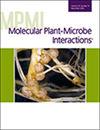求助PDF
{"title":"番茄斑萎病毒蛋白质定位可视化:蛋白质-蛋白质相互作用的跨域比较。","authors":"K M Martin, Y Chen, M A Mayfield, M Montero-Astúa, A E Whitfield","doi":"10.1094/MPMI-09-24-0108-R","DOIUrl":null,"url":null,"abstract":"<p><p>Tomato spotted wilt virus (TSWV) is an orthotospovirus that infects both plants and insect vectors, and understanding its protein localization and interactions is crucial for unraveling the infection cycle and host-virus interactions. We investigated and compared the localization of TSWV proteins. The localization between plant and insect cells was overall consistent, indicating a similar mechanism is utilized by the virus in both types of cells. However, a change in localization over time was associated with the viral proteins that did not contain signal peptides and transmembrane domains such as N, NSs, and NSm, which only occurred in the plant cells and not in the insect cells. We also tested the localization of the proteins during an active plant infection using free red fluorescent protein (RFP) as a marker to highlight the nucleus and cytoplasm. Voids in the cytoplasm were shown only during infection, and N, NSs, NSm, and to a lesser extent G<sub>N</sub> and G<sub>C</sub> were surrounding these areas, suggesting it may be a site of replication or morphogenesis. Furthermore, we tested the interactions of viral proteins using both bimolecular fluorescence complementation (BiFC) and membrane-based yeast two-hybrid (MbY2H) assays. These revealed self-interactions of NSm, N, G<sub>N</sub>, G<sub>C</sub>, and NSs. We also identified interactions between different TSWV proteins, indicating their possible roles, such as between NSs and G<sub>C</sub> and N and G<sub>C</sub>, which may be necessary during the replication and assembly processes, respectively. This research expands our knowledge of TSWV infection and elaborates on the intricate relationships between viral proteins, cellular dynamics, and host responses. [Formula: see text] Copyright © 2025 The Author(s). This is an open access article distributed under the CC BY-NC-ND 4.0 International license.</p>","PeriodicalId":19009,"journal":{"name":"Molecular Plant-microbe Interactions","volume":" ","pages":"84-96"},"PeriodicalIF":3.4000,"publicationDate":"2025-02-01","publicationTypes":"Journal Article","fieldsOfStudy":null,"isOpenAccess":false,"openAccessPdf":"","citationCount":"0","resultStr":"{\"title\":\"Visualizing Tomato Spotted Wilt Virus Protein Localization: Cross-Kingdom Comparisons of Protein-Protein Interactions.\",\"authors\":\"K M Martin, Y Chen, M A Mayfield, M Montero-Astúa, A E Whitfield\",\"doi\":\"10.1094/MPMI-09-24-0108-R\",\"DOIUrl\":null,\"url\":null,\"abstract\":\"<p><p>Tomato spotted wilt virus (TSWV) is an orthotospovirus that infects both plants and insect vectors, and understanding its protein localization and interactions is crucial for unraveling the infection cycle and host-virus interactions. We investigated and compared the localization of TSWV proteins. The localization between plant and insect cells was overall consistent, indicating a similar mechanism is utilized by the virus in both types of cells. However, a change in localization over time was associated with the viral proteins that did not contain signal peptides and transmembrane domains such as N, NSs, and NSm, which only occurred in the plant cells and not in the insect cells. We also tested the localization of the proteins during an active plant infection using free red fluorescent protein (RFP) as a marker to highlight the nucleus and cytoplasm. Voids in the cytoplasm were shown only during infection, and N, NSs, NSm, and to a lesser extent G<sub>N</sub> and G<sub>C</sub> were surrounding these areas, suggesting it may be a site of replication or morphogenesis. Furthermore, we tested the interactions of viral proteins using both bimolecular fluorescence complementation (BiFC) and membrane-based yeast two-hybrid (MbY2H) assays. These revealed self-interactions of NSm, N, G<sub>N</sub>, G<sub>C</sub>, and NSs. We also identified interactions between different TSWV proteins, indicating their possible roles, such as between NSs and G<sub>C</sub> and N and G<sub>C</sub>, which may be necessary during the replication and assembly processes, respectively. This research expands our knowledge of TSWV infection and elaborates on the intricate relationships between viral proteins, cellular dynamics, and host responses. [Formula: see text] Copyright © 2025 The Author(s). This is an open access article distributed under the CC BY-NC-ND 4.0 International license.</p>\",\"PeriodicalId\":19009,\"journal\":{\"name\":\"Molecular Plant-microbe Interactions\",\"volume\":\" \",\"pages\":\"84-96\"},\"PeriodicalIF\":3.4000,\"publicationDate\":\"2025-02-01\",\"publicationTypes\":\"Journal Article\",\"fieldsOfStudy\":null,\"isOpenAccess\":false,\"openAccessPdf\":\"\",\"citationCount\":\"0\",\"resultStr\":null,\"platform\":\"Semanticscholar\",\"paperid\":null,\"PeriodicalName\":\"Molecular Plant-microbe Interactions\",\"FirstCategoryId\":\"99\",\"ListUrlMain\":\"https://doi.org/10.1094/MPMI-09-24-0108-R\",\"RegionNum\":3,\"RegionCategory\":\"生物学\",\"ArticlePicture\":[],\"TitleCN\":null,\"AbstractTextCN\":null,\"PMCID\":null,\"EPubDate\":\"2025/1/23 0:00:00\",\"PubModel\":\"Epub\",\"JCR\":\"Q2\",\"JCRName\":\"BIOCHEMISTRY & MOLECULAR BIOLOGY\",\"Score\":null,\"Total\":0}","platform":"Semanticscholar","paperid":null,"PeriodicalName":"Molecular Plant-microbe Interactions","FirstCategoryId":"99","ListUrlMain":"https://doi.org/10.1094/MPMI-09-24-0108-R","RegionNum":3,"RegionCategory":"生物学","ArticlePicture":[],"TitleCN":null,"AbstractTextCN":null,"PMCID":null,"EPubDate":"2025/1/23 0:00:00","PubModel":"Epub","JCR":"Q2","JCRName":"BIOCHEMISTRY & MOLECULAR BIOLOGY","Score":null,"Total":0}
引用次数: 0
引用
批量引用

 求助内容:
求助内容: 应助结果提醒方式:
应助结果提醒方式:


